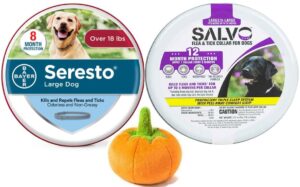Newer Options For Flea And Tick Control On Your Dog And Cat
Ron Hines DVM PhD
 Flea Control On Dogs & Cats In General
Flea Control On Dogs & Cats In General
 Flea Products That Also Cure Mange & Ear Mites
Flea Products That Also Cure Mange & Ear Mites
Flea and tick medications are projected to earn pharmaceutical companies 4 billion dollars in 2021 and to reach 10 billion by 2026. It is a very lucrative business with product ingredients costing next to nothing and a very high markup. It is also a highly competitive business. Product selection, marketing strategies and effectiveness claims constantly change. Manufacturers of the best-selling name brands are always in the process of developing new formulations as the ingredients in their current products lose patent protection and face generic competition. So, an article like this one is accurate only for a brief moment. Regulatory bodies throughout the world (FDA, EMA, APVMA, ERMA etc.) stay busy crafting new labels and warnings. You are always safest when you read the product insert that came with the actual flea and tick control product that you just bought. The ones I might provide links to in my articles may not be the current labels at the time you read the article. And my articles are never guaranteed to be typo or error free.
Changing dog and cat-owner attitudes over the years also drive this market. Folks like you are willing to spend considerably more money on your dog and cat than they were not that long ago. Preferences change too. Many of you would prefer a tasty chewable pill for your pet over a messy and smelly liquid that you have to drip on your cat or dog’s back (“spot-on” products).
Another thing that drives your product choices, spurs sales and propels innovation is our increasing awareness of the many nasty diseases that fleas and ticks transmit. Many of those diseases, like Lyme disease, typhus, tularemia, Rocky mountain fever, anaplasmosis and ehrlichia, ticks and fleas from a disease-infected pet can spread to you too. CDC reports indicate that the incidence of those diseases is rising. see here Whether that is due to better surveillance, rising numbers of feral cats, global warming or more urban wildlife vectors (e.g. raccoons, deer & deer mice) is unknown. I tend to believe it is a combination of all four of them.
Whether that is due to better surveillance, rising numbers of feral cats, global warming or more urban wildlife vectors (e.g. raccoons, deer & deer mice) is unknown. I tend to believe it is a combination of all four of them.
Isoxazoline Flea & Tick Control Oral Chewables
NexGard® (afoxolaner), Bravecto® (fluralaner), Simparica® (sarolaner) and Credelio® all contain similar related compounds called isoxazolines. These compounds are distant relatives of fipronil – the active ingredient in Frontline®. Of the four, NexGard has been on the market the longest (since 2013). So, owner feedback on that medication is the largest. Although some of these oral products say that they can be safely used with other flea control products, I would be quite cautious if you attempt to do so. If they are not solving your flea and tick problem on their own, you probably need to make other non-drug adjustments to your pet’s lifestyle and flea and tick exposure risk. Read more about many of those products for dogs and for cats here: 
Are New And Old\ Oral Flea/Tick Products More Effective Than Topical Flea And Tick Control Products?
None of the studies I know of that compare the effectiveness of the four new isoxazoline products show them to be significantly more effective than traditional topical or oral products that have been on the market for a long time.
Almost every published study was entirely financed by one manufacturer or the other and, not surprisingly, found that their product was the most effective of the four. What they do offer is convenience and the lack of owner exposure to messy and smelly topical liquids. Some dogs and cats are irritated by topical flea/tick control products. They can lose hair and show evidence of skin irritation at the point of application. That can be usually solved by never placing more than a drop or two in any one spot. But these new oral products eliminate the possibility of point-of-application issues. The trade-off in occasional dogs are digestive tract issues (vomiting, lethargy, diarrhea, and a lack of appetite) and, on rarer occasions, more serious issues. see here: 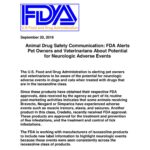
Here Are Two Possible Advantages Of Oral Flea/tick Preventatives:
![]() You and your kids won’t get as much exposure to the chemicals they contain. If your dog and cat groom each other, cats won’t get as much exposure either.
You and your kids won’t get as much exposure to the chemicals they contain. If your dog and cat groom each other, cats won’t get as much exposure either.
![]() You won’t have to struggle to get topical products down to the skin in thick coated, belligerent or overactive pets. Dogs with skin problems can be difficult to medicate topically. You don’t have to wait to bathe your dog or take it swimming.
You won’t have to struggle to get topical products down to the skin in thick coated, belligerent or overactive pets. Dogs with skin problems can be difficult to medicate topically. You don’t have to wait to bathe your dog or take it swimming.
On the other hand, when a pet has a bad reaction to a topical product, that product can be washed off. Oral products are also more likely to cause vomiting, diarrhea and indigestion than topical ones used as directed. It is also possible for your dog to vomit back the medication without you being aware of it – so it is best to observe your dog for an hour or so after offering it any oral flea/tick control product. Some of the manufacturers have been known to refund the cost of an oral dose lost that way. Dogs are not squeamish about what they eat. The pill or chew, once expelled, might even be eaten by another of your pets.
Here Are Some Of Your Choices In Oral Flea/Tick Medications:

NexGard® afoxolaner
NexGard® beef-flavored chews kill adult fleas and several species of ticks. Through early 2019, NexGard® is not approved for use in cats. The product also appears to be helpful in curing dogs with mange. One dose gives one month’s protection against fleas and ticks to most dogs. A few dogs are reluctant to eat it. It can be given on a full or empty stomach. The drug has no effect on flea eggs. It has no effect on mosquitoes or heartworms.
Boehringer Ingelheim/Merial, the manufacturer, claims that NexGard® kills 99% of fleas and ticks in 8 hours. NexGard® does not repel fleas or ticks. They warn that NexGard® should not be given to dogs with a history of seizures (e.g. epilepsy) and that its safety in pregnant, nursing and breeding dogs has not been established.
In 2018, NexGard® was also approved by the FDA as a preventative against Lyme tick and Lyme disease exposure in dogs. No matter what product you end up using, you are likely to find that ticks are considerably harder to kill than fleas. As with all the isoxazoline (the ones ending in “laner”) vomiting, lethargy, diarrhea, and a lack of appetite the most common unwanted side effects. Dogs need to weight 4 pounds and be at least 8 weeks old to receive it.
Boehringer and the other companies that market isoxazolines do their best to restrict sales to veterinarians and online merchants requiring a veterinary prescription. NexGard® entered the veterinary market in 2013, so we have more dog-owner feed back on it than on the other three isoxazoline medications that follow:
Bravecto® fluralaner
Bravecto®, produced by Merck, is another isoxazoline compound. It is marketed as a soft chew or beef-flavored tablets for dogs. It kills the same spectrum of parasites as NexGard®, but the Company claims its parasite-killing ability lasts up to three months (2 months for certain ticks: for Amblyomma on the US label, 4 months on the Australian label. It is proven effective in curing most cases of mange after 1–2 doses. It also kills ear mites. The company claims that 98% of the fleas on a dog are dead after 12 hours. At least in some countries, Bravecto® is approved for use in breeding, pregnant and lactating dogs. Bravecto® alone has no effect on mosquitoes or heartworms, Bravecto Plus does prevent heartworm infection. The company suggests it be given with food. Side effects, when they occur, are the same as for NexGard® and the other isoxazolines with the possible addition of increased thirst. Dogs receiving the product need to be six months old or older. I believe that has more to do with a young dog’s changing weight than increased sensitivity at an earlier age. Dogs need to weigh at least 4.4 pounds. Bravecto® is also marketed in a topical formula that is approved for both dogs and cats weighing at least 2.6 lbs. and for kittens aged 6 months or older.
Credelio® lotilaner
In June of 2018, Elanco (the animal division of Eli Lilly) received FDA approval to market Credelio®, another isoxazoline medication directed at fleas and ticks. The Company markets Credelio® as being effective against fleas and ticks for “a full month”. Credelio® is a beef-flavored chewable tablet. The label requires dogs receiving it to be eight weeks of age or older and weigh at least 4.4 pounds. Although the direction label says there are no known contraindications for the use of Credelio®, farther down on the label it says that it should be used with caution in dogs that have experienced seizures in the past and that the drug’s use in breeding, pregnant or nursing dogs has not been studied. It goes on to say that kidney issues (increased BUN, excessive drinking & urination, high blood potassium and phosphorus, head tremors and weight loss occurred in a few of the test dogs that received the medication). Older dogs appeared at increased risk. A few dogs in one of their European studies vomited or developed diarrhea subsequent to the drug’s administration. Elanco lists more possible side effects for Credelio than the other three pharmaceutical companies marketing competing isoxazoline products. That does not necessarily mean their product is less safe than the others. Elanco could just be more thorough and forthcoming in presenting information than the other pharmaceutical companies competing for your purchase. The Eli Lilly companies have a reputation for transparency. Elanco also found that dogs 2 months of age eliminated the drug from their bodies considerably faster than those that were 10 months old. So young dogs may not get a full month’s benefit from their monthly dose. They also found that food in the pet’s stomach or given simultaneously with Credelio® was important for full drug absorption.The company’s studies reported that 99% of the fleas were killed within 4 hours after Credelio® was given. In one study, it took about 48 hours for ticks to die, in another four hours. It’s effective against ticks lasted for one month. A special oral feline Credelio® formulation is approved for cats.
Simparica® sarolaner
Simparica® is Zoetis’ version of isoxazoline. It came on the market in 2016. Zoetis is the veterinary spin-off of the Pfizer Drug Company. The medication is sold as a liver flavored chewable tablet. Like NexGard and Credelio, it is said to offer protection against fleas and ticks for one month. Zoetis claims the medication begins killing fleas in three hours and ticks within 8 hours and that one dose is 96.9% effective for 35 days. It is for use in dogs weighing at least 2.8 lbs and 6 months of age or older. As with the other isoxazolines, its most common side effects if they occur are vomiting and diarrhea., It too has occasionally been associated with neurological signs such as tremors, unsteady gait, and seizures. It has not been evaluated in pregnant, breeding or nursing dogs. Word of mouth says that Simparica® also kills the mites responsible for demodectic mange (demodex), sarcoptic mange (scabies), and otodectic mange (ear mites).
Trifexis®
Trifexis® is another Elanco product. It was approved by the FDA in 2011 for use in dogs. Trifexis® comes as a beef-flavored chewable tablet. The spinosad in this medication is there to kill fleas. At the recommended dose it does not kill ticks. The milbemycin deals with the heartworm larva carried by mosquitoes as well as intestinal hookworms, roundworms and whipworms. It does not kill tapeworms. Trifexis® is designed to be given monthly. Elanco also manufactures the same Trifexis® ingredients under the name ComboGuard®, a product often distributed through VCA animal hospitals. Dogs need to be checked for heartworms before beginning this product. Elanco suggests that Trifexis® be given on a full stomach. That seems to reduce the chances of nausea following ingestion of the tablet and increase spinosad’s absorption. Trifexis® is approved for use in dogs and puppies 8 weeks of age or older that weigh 5 pounds or more. The Company states that the spinosad in the tablet begins killing fleas in 30 minutes and that all the fleas should be dead 4 hours later. Spinosad is considered to be one of the safest insecticides. It is one of the very few considered acceptable by organic gardeners because it is a natural constituent of certain soil bacteria. Milbemycin oxime is also considered a safe drug. But it needs to be given with caution to dog breeds that are known to have the MDR1 gene mutation – particularly when they are concurrently receiving ivermectin as a treatment for sarcoptic or demodectic mange or if they might accidentally be given another heartworm preventative in addition to Trifexis® or another milbemycin-containing product. Dogs should be tested for heartworms before beginning this or any heartworm preventative. That is because the sudden death of heartworm larva (microfilaria) in a heartworm positive dog can cause reactions. On a competitive product containing milbemycin (Sentinel®), their website notes that milbemycin can fail to prevent heartworms when a dog was bitten by an infected mosquito up to six months prior to the dog beginning milbemycin.
When side effects of Trifexis® occur, the most common one is vomiting. Less common are reduced appetite and diarrhea. Some get around that by splitting the monthly dose into two daily portions. Trifexis® is not approved for use in cats. Since Trifexis does not kill ticks, it is a poor choice when tick exposure is anticipated. As with all of these oral products, a few dogs develop side effects more serious than vomiting.
As I mentioned earlier, some of these oral flea and tick control combination medications lower the bar to seizures and increase the risk of side effects when given to heartworm positive dogs or dogs receiving other medications such as ivermectin for mange problems.

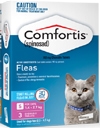
Comfortis®
Comfortis® is another Elanco spinosad-containing product. When sold through the VCA animal hospital chain, it is marketed as AcuGuard®. It comes as a flavored chewable tablet. Comfortis® received FDA approval in 2007. It kills fleas on dogs and cats. Elanco suggests a dose be given monthly. According to the company’s website, Comfortis® begins killing fleas 30 minutes after the dose is given. In dogs, one hundred percent of the fleas were said to have died within four hours and the flea populations of dogs still reduced by 97.9% one month after receiving their last dose. In cats, 98% of the fleas are said to be dead in four hours and 99.9% reduced after 3 consecutive monthly doses. For maximum effectiveness, the Company suggests that Comfortis® be given along with food.
Comfortis is a great option for cats that will readily accept it – although my preferred option is to just keep your cats indoors. Comfortis® is FDA-approved for cats 14 weeks old and older and weighing at least 4.1 lbs/1.86 kg. In the tablet sizes marketed for dogs. Dogs receiving Comfortis need to be 14 weeks old or older and weigh at least 3.3 lbs/ 1.5 kg.
Comfortis® does not kill ticks – at least not at the relatively safe doses suggested. Vomiting back the pill can be a problem and Comfortis® should not be given when other products to control heartworms or treat mange are also given (e.g. ivermectin, moxidectin, milbemycin, selamectin). Comfortis®, like many flea products, is less safe to give dogs with a history of seizures. Like most of these flea/tick products, they have not been tested in pregnant or breeder dogs. Such tests, conducted scientifically, would be prohibitively expensive. is
The most common side effect of Comfortis®, when one occurs, is vomiting and lack of appetite. But depression, incoordination, diarrhea, itching, tremors, excessive is salivation and even seizures have occasionally been reported.
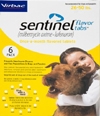
Sentinel®
Sentinel® is a Virbac product. It is FDA-approved for monthly administration to dogs. Virbac specializes in veterinary products that contain active ingredients whose patents have already expired – allowing them to be marketed at a lower price. Virbac is required to go through the same rigorous FDA approval process as the more expensive brands. Dogs need to be checked for heartworms before beginning this product. Sentinel contains lufenuron for fleas, milbemycin for heartworms and praziquantel for tapeworms. In 2019, the Sentinel website states that milbemycin can fail to prevent heartworms when a dog was bitten by an infected mosquito up to six months prior to the dog beginning milbemycin. Milbemycin also kills intestinal hookworms, whipworms and roundworms. Sentinel®’s flea-fighting ingredient, lufenuron, does not kill adult fleas and it does not kill ticks. It prevents flea eggs from hatching. That might make it somewhat helpful in a multipronged flea-control program. But Sentinel® is unlikely to eliminate a flea problem on its own – at least not rapidly enough for most dog owners to be satisfied.


Capstar®
Capstar® is another Elanco product. Prior to 2014, it was manufactured by Novartis. It is an oral tablet for dogs, puppies, cats and kittens 4 weeks of age or older and 2 pounds of body weight or greater. Its active ingredient is nitenpyram. It is designed to kill adult fleas. Elanco suggests the pill be hidden in a food treat and that you observe your pet for a while afterward to be sure the pill was not spit out. It reminds you that all pets in the household need to be treated at once. The drug is said to begin killing fleas within 30 minutes and had killed 90% of the fleas on dogs within four hours and on cats within 6 hours.
When side effects occur in cats, they have been reported as hyperactivity, mopiness (lethargy) meowing, vomiting, fever, lack of appetite, nervousness, diarrhea, difficult breathing, salivation, incoordination, seizures, dilated eyes, increased heart rate and trembling. When side effects occur in dogs, they have been reported as mopiness, depression, vomiting, itching, decreased appetite, diarrhea, hyperactivity, incoordination, trembling, seizures, panting hives, vocalization, salivation, fever and nervousness. Side effects tended to be more serious and occurred more frequently when Capstar® was given to pets under two pounds body weight and less than 8 weeks of age (not suggested for those pets). Elanco says that they believe that itching hyperactivity, panting and licking subsequent to administering Capstar® is due to the dying fleas – not a direct effect of the medication.
Topical Flea And Tick Control Products


Frontline Plus®
I started the topical product list with Boehringer Ingelheim/Merial’s Frontline Plus because most everybody is acquainted with that brand. It contains fipronil & methoprene. Currently, the flea and tick-killing compound (fipronil) that it contains is readily available in many generic brands that are identical in their actions to Frontline®. They can be purchased without a prescription online and at bigbox stores. These products control fleas and ticks for one month. Fipronil products kill fleas in 8-24 hours and ticks somewhat longer. The methoprene is added to suppress the hatching of flea eggs. Dogs and cats that will not readily accept pills or chews can often be medicated topically with these products.
The dog formulation is approved for use on all dogs at least 8 weeks old and weighing at least 5 lbs/2.3 kg once per month. The cat formulation is approved for use on cats and kittens 8 weeks old or older that weigh over 1.5 Lbs/0.7 Kg. If you own a rabbit as well, do not use these products on them. There are at least 15 similar generic over-the-counter brands. Never use any of them that contain a compound ending in “thrin” (such as permethrin, cyphenothrin, etc.) on a cat.
Boehringer Ingelheim/Merial also produces a product called Frontline Tritak®. It is designed to repel ticks and fleas in addition to killing those already on the pet. The Tritak formula for dogs is different from the Tritak formula for cats. I have no experience using Tritak® on dogs and cats. But I noticed that the Tritak® line is no longer available through many of the large internet suppliers.

Certifect®
This is another Boehringer Ingelheim/Merial product. Certifect® combined fipronil, methoprene and amitraz. Amitraz was added as a powerful tick killing compound to their topical Frontline formula for added effectiveness against ticks. Because amitraz is considerably more toxic to cats than dogs, Certifect® was a dog-only product. Some even suggest it not be used when dogs and cats have close contact. The European Medical Agency website lists Certifect® as “The marketing authorization for Certifect® has been withdrawn at the request of the marketing-authorization holder”.


Duoflect®
Ceva Animal Health launched Duoflect®, a new topical spot on, that contains a formulation of fipronil and (s)-methoprene that claims to offer 100–150% longer duration of action against fleas in cats (eight weeks?), and 13-50% longer duration in dogs (nine weeks?) than the Frontline fipronil/methoprene combinations. How much longer depends on which of their ads you read. I have no experience using this product. It was launched in the UK and Europe.
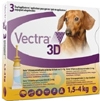
Vectra 3D®
Notice that Vectra3D® contains a “thrin” ingredient. That means it is unsafe to give it to cats. Vectra 3D® contains permethrin, dinotefuran and pyriproxyfen. It is also manufactured by Ceva Animal Health. It is marketed to kill adult fleas and ticks. The dinotefuran kills fleas and ticks. The permethrin in it kills and repels mosquitoes, lice, ticks and biting flies. The pyriproxyfen in it prevents flea eggs from developing into adult fleas. It is marketed as killing fleas as early as 2 hours after application with 96% of the fleas destroyed within 6 hours. It is designed for monthly topical application to dogs older than 7 weeks and weighing at least 2.5 lbs/ 1.13 kg. It is highly toxic to cats.
Warnings on the label state: Do not use this product on debilitated, aged, medicated, pregnant or nursing dogs, or dogs known to be sensitive to pesticide products without first consulting a veterinarian. Sensitivity, such as slight transitory redness (erythema) or pruritus (itching) at the site of application, may. If signs of sensitivity occur, bathe your dog with mild soap or shampoo and rinse with large amounts of water. If signs of individual dog sensitivity occur and persist, contact your veterinarian.
Ceva markets a second Vectra designed for cats. It contains no permethrin (the most toxic to cats) – only dinotefuran and pyriproxyfen. Instructions say it is safe for cats over 8 weeks old that weight at least 2 lbs/ 0.9 kg.
Warnings on the label state: Do not use on debilitated, aged, medicated, pregnant or nursing animals, or animals known to be sensitive to pesticide products without first consulting a veterinarian. Sensitivity, such as slight transitory redness of the skin at the site of application, may occur after using. If signs of sensitivity occur, bathe your pet with mild soap or shampoo and rinse with large amounts of water. If signs of individual animal sensitivity occur and persist, contact your veterinarian.


Revolution®
Revolution® is manufactured by Zoetis. Its active ingredient is selamectin. The correct size with the correct animal image on the box is considered safe to use topically on dogs and cats. Dogs need to be checked for adult heartworms before beginning this product. Revolution® kills adult fleas and ticks. It also kills the sarcoptic form of mange. It kills roundworms and hookworms. It kills heartworm larva carried by mosquitoes. It must be applied topically monthly. It often takes one or two days to rid a pet of fleas. It does not kill all tick species your pet might be exposed to.
I used it for several years on my dog Maxx. It was quite effective in preventing fleas and I liked the fact that the product also guarded against heartworms. But after time, it appeared to sting him at the points of application and I switched him over to topical Advantage Multi® because of that and because the moxidectin in Advantage Multi had been found more effective for a full month of heartworm protection.
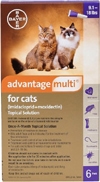
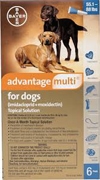
Advantage Multi®
Advantage Multi® is marketed by Bayer. It contains imidacloprid and moxidectin. The product marketed with a dog on the package is only for dogs. A second product is marketed for cats. The imidacloprid in it kills adult fleas, the moxidectin kills larval heartworms that transfer to your dog through mosquitoes bites. It is even used in some animal shelters and by some veterinarians as a “slow kill” method of reducing adult heartworm numbers. Dogs need to be checked for heartworms before beginning Advantage Multi®. Moxidectin also kills hookworms, roundworms and is useful in treating sarcoptic mange. Bayer also sells an Advantage Multi for cats. Advantage Feline has the same spectrum of protection as Advantage Multi for dogs. However, Bayer warns on its website that their dog product must never be used on cats. The cat product is also said to be safe to use on pet ferrets.
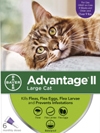
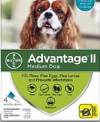
Advantage II®
Advantage II® is a similar Bayer product that only kills fleas and retards flea eggs from developing into adult fleas. It has no effect on heartworms. It is not suggested to control ticks. It contains imidacloprid and pyriproxyfen. The product is sold in sizes appropriate for both dogs and cats. For cats, use packages with a cat on the label.
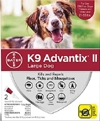
K9 Advantix II®
K9 Advantix® is a topical Bayer product similar to Advantage II®, but with permethrin added to increase its ability to kill and repel ticks, mosquitoes and biting flies. Consequently, it should not be used on cats.

Cheristin®
Cheristin® is an Elanco (Eli Lilly) product. It is designed for use on cats. The product contains spinetoram, an analog (=similar to) of spinosad. The two drugs are quite safe and are considered “toxicologically equivalent” (=just as safe). Spinosad is even approved for organic gardening. It is sold as topical drops. It is very effective in killing fleas for a month. But it has no effect on ticks.
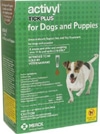
Activyl Tick Plus®
Activyl Tick Plus® is a Merck product. It is designed for use on dogs and should not be used on cats. Its active ingredients are inoxacarb and permethrin. It is said to kill fleas within 8 hours and continues to be effective for about a month. The permethrin acts as a tick repellent and also kills fleas. If you have a cat as well as a dog, you should be cautious that they do not rub against each other. Permethrin is quite toxic to cats but not to dogs or humans.
Flea & Tick Collars
There is a new generation of flea and tick collars that are much more effective than traditional flea collars we once used.
Seresto®
Seresto®, a Bayer product, utilizes a polymer matrix that allows the active ingredients to slowly diffuse from the collar over 8 months. It comes in units sold specifically for dogs or for cats. Don’t use the wrong one. Seresto® kills fleas and most species of ticks. It kills lice. But lice problems are quite rare on dogs and cats. Both contain flumethrin and imidacloprid as their active ingredients. Imidacloprid is the same ingredient found in their Advantage® line of topical products like Advantage®. When side effects occur, they are generally limited to redness, hair loss and inflammation in the area beneath and surrounding the collar. Cats need to be at least ten weeks old and puppies at least seven weeks old before using Seresto®.
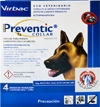

Preventic Collars®
Preventic® is a Virbac product. It is for use on dogs only. It is effective in killing ticks. One collar is effective for about 3 months. It does not kill fleas. It is not waterproof – water caused the active ingredient, amitraz, to leach out. It can also be toxic if your dog eats or chews on the collar or if another pet does. At the time I wrote this article, the Virbac site only displayed an error message for the product ingredients and suggested use. Products like this that contain amitraz should never be used on cats. In Australia, it carries a poison warning.
Which Of These Products Lasts The Longest?
Some pet owners complain that flea products don’t last as long as advertised. Nothing will immediately eliminate fleas in a heavily infested environment. In other cases, the product was not applied correctly. Topical drops work best when each drop touches the skin and the pet is not bathed for two days after the application is applied. Despite what labels say, it is possible to scrub off a lot of protection with vigorous soapy baths. There is little evidence to date that oral flea/tick preventatives are any more effective than topically applied ones. (read here) But currently Merck, the marketer of Bravecto® flavor chews and topicals, claims that in pets over 6-month-old, Bravecto (fluralaner) prevents fleas for 12 weeks after a single dose. (read here) However, after month two, the concentration of fluralaner in your pet’s body is considerably reduced. (read here)
For dogs, Advantage Multi® has been very effective for me when applied once a month. Revolution® appears equally effective, but has caused some redness and inflammation at the points where the drops were applied. For cats that will accept it, oral Comfortis® is a very effective oral flea treatment. For cats that won’t, Cheristin® also works well.
You are on the Vetspace animal health website
Visiting the products that you see displayed on this website help pay the cost of keeping these articles on the Internet.






